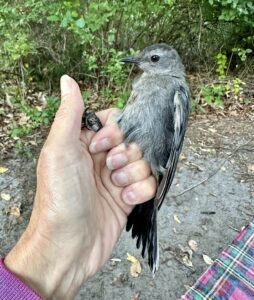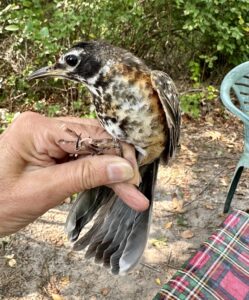BREWSTER — I pulled into the parking lot of the Cape Cod Natural History Museum at 5:30 a.m. on a mid-August morning that was hot and humid even at that early hour. Wing Island — a 300-acre patch of tree-covered land in the middle of the bayside salt marsh between Paine’s Creek and Quivett Creek — was sure to be overgrown and damp. I was told to bring the tallest boots I had.
I was there to meet Sue Finnegan and two other volunteers for a morning of banding birds. Finnegan is the master bander of the Wing Island Banding Station, which is located on museum property adjacent to the town’s conservation land. She and her team have been banding birds here since 2000, and the information they gather is reported to the Bird Banding Laboratory, a division of the U.S. Geological Survey, which distributes banding permits and collects all the data gathered by banders across North America. All told, banders have tagged 75 million birds across the continent since 1960 — and Sue and the volunteers at Wing Island are responsible for 62,000 of those.
This massive repository of data has helped uncover migration routes, revealed the way birds age, and illustrated how human activity is affecting birds. Most recently, bird banding data helped reveal that wildfire smoke causes birds to go hungry.
Banding is among the oldest scientific tools we have for studying birds. The technique typically involves capturing birds in mist nets, which resemble tennis nets but are twice as tall and with string so fine that they are nearly invisible. Birds fly into the nets and are held gently there until a bander extracts them.

When a bird is brought back to the station, an experienced bird bander puts an aluminum ring with a unique nine-digit code on its leg. These bands make each bird individually identifiable — if a banded bird is recaptured elsewhere, we can look at the two data points to learn how this bird has migrated between the two captures. The bander determines the bird’s age and sex and records those and some other measurements, then the bird is released.
I’ve been extracting and banding birds since I was a teenager. I spent an entire spring at a banding station in Ontario when I was in college, quickly followed by two other field jobs that involved banding endangered birds. But I hadn’t been to a banding station in three years. I was sure to be rusty.
The air was stagnant, but all around us we could hear the chirps and squeaks of birds waking up as we opened the mist nets. We finished, returned to the station, and set up the banding equipment. Then, just a few minutes later, we went to check our nets for the first time.
It was clear this was going to be a busy day for the station. Nearly all of the 25 or so nets had birds in them. Most were gray catbirds. These black-capped long-tailed birds breed on Wing Island in huge numbers. The birds we caught ranged from full-fledged adults to fledglings barely two weeks out of the nest.
Sue watched me extract the first catbird. These birds are feisty, and this one flailed and clawed and screeched as I worked the netting from its wings, feet, and head. The net felt foreign in my hands, but slowly my feel for the task returned, and I worked the bird out of its tangle, slipped it into a cloth bag, and hung it from a clip around my neck. Birds are transported this way around the banding station; the bags provide a dark, safe environment that keeps them calm.
At the end of the first round of net checks, Sue trusted me to extract birds on my own, and I came back to the station with six birds for her and others to band. Then it was already time to check the nets again.
As the air warmed up, the midges started biting (OK, I’m from Canada; you call these “no-see-ums”), and as I’d finish one extraction another catbird would hit the net. A couple of hours passed in a blur.

Then, at some point deep into the morning, I was extracting yet another catbird — by this point surely number 18 or 19 — when I locked eyes with it.
My mind flashed back to the first bird I ever extracted from a net by myself. I was 15, volunteering at a banding station in my hometown of Ottawa, Ontario. I was sent to check a series of nets with another volunteer, but for one reason or another I had been left alone when I came upon an American tree sparrow cradled in a pocket of a net.
Other banders would be back soon, and I could have left the bird for them to extract. But in that moment, I was overcome. Looking into its eyes, I saw many other animals I knew — the heterochromatic eyes of my two-year-old Australian shepherd, Maisy, the soft warm eyes of my recently deceased dog, Maggie, the cautious eyes of squirrels scampering around my birdfeeder. I felt that I saw in its eyes the soul of the natural world.
I had to take the sparrow out myself. I cupped the bird in one hand. It wasn’t too tangled. I got one strand of the net over its right wing, then one strand over its wrist bone, then another, and one wing was free.
As my grip loosened, the sparrow suddenly flapped. I gasped but kept holding the bird, and as it calmed down, I focused. I pinched my fingernails around a strand of netting behind its head and pulled upward, lightly pressing on its beak for leverage. The netting slipped off and its head was free. A few moments later, the other wing was out, and the bird let go of the netting it was clasping in its feet. I lifted the bird, finally free of the net, and, my heart racing, I slipped it into the cloth bag, tied the top, and brought it back to the banding station. I’ve never forgotten that experience.
When you see birds from afar, it can be easy to dismiss them as mere shapes in the branches or flocks on the beach. But held in your hand, a bird becomes so much more real.
By the end of the day, we’d banded 116 birds. I extracted 26 catbirds, plus a robin, five common yellowthroats, and two prairie warblers. I’ll be back to Wing Island soon, I’m sure. Getting to see my favorite animals up close is too good an opportunity to pass up.
